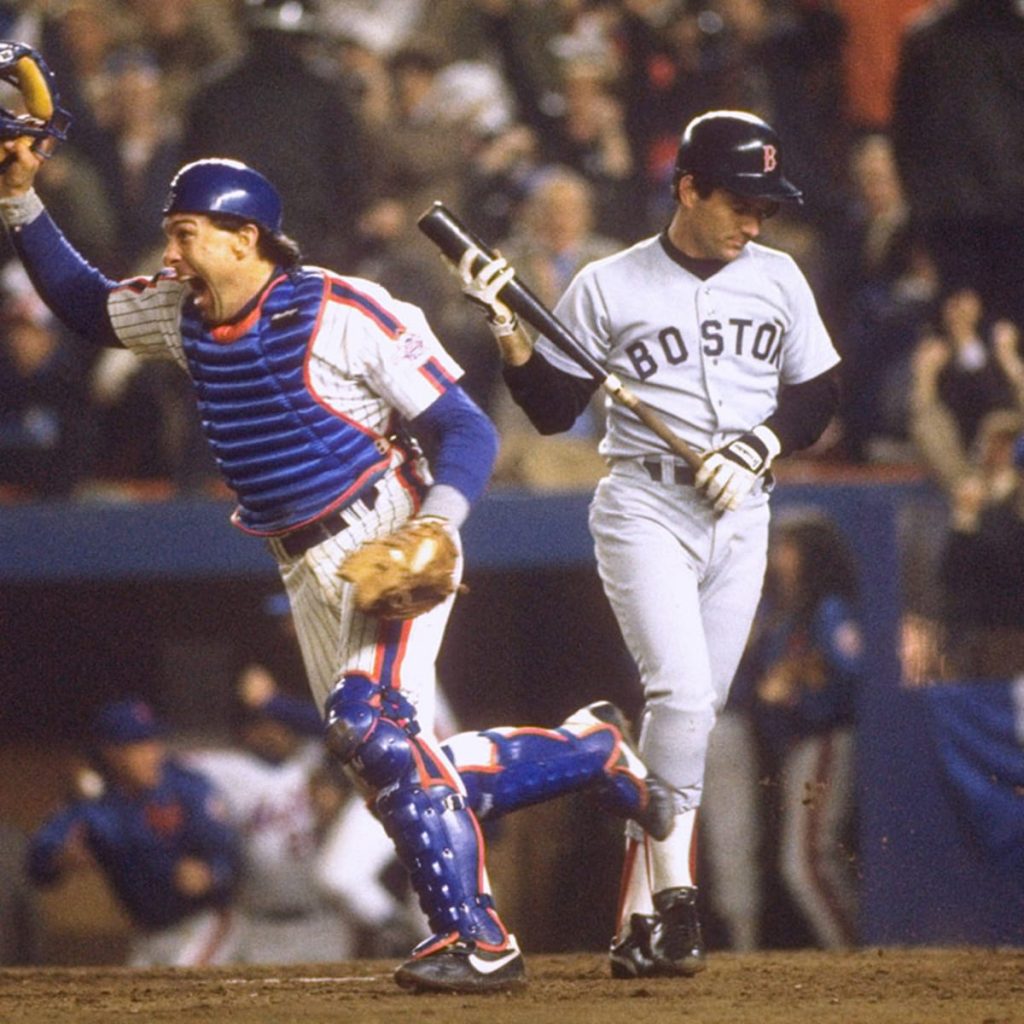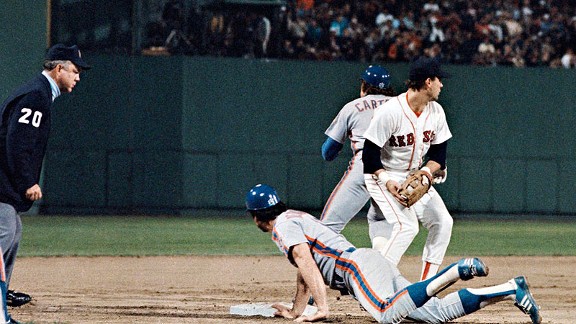Why Teams Wear Grey When Not At Home

Pictured above is a magical moment from October 27, 1986. The man dressed in white with the blue chest protector is the late Gary Carter, the catcher for the home team New York Mets. The man in grey with “Boston” across his chest is Marty Barrett, a player for the Boston Red Sox. If you want to know what happened in that game, I’m glad to talk about it at extraordinary length, but for today, let’s talk about their clothes.
To do so, we’ll need to look at another picture, below. It’s the same two teams from just six days prior and, in fact, Carter is again in the photo. He’s the guy with his back turned to us, standing. In the foreground is his teammate, Keith Hernandez. Both are wearing grey uniforms. Between them, wearing a white uniform reading “Red Sox” is Spike Owen, a teammate of Marty Barrett’s. (In fact, in the photo, Owen is about to throw the ball to Barrett.)

To recap the laundry situation:
In the first photo, the Mets are wearing white and the Red Sox are wearing grey. In the second photo, the Mets are wearing grey while the Red Sox are wearing white. Most fans will immediately know why: in baseball, the home team traditionally wears white uniforms and the visitors typically wear grey ones. It seems like an arbitrary guideline (and in fact, it’s become less true over the years), but it’s not. It’s practical — or, it was, originally.
Organized professional baseball has been around for nearly 150 years; the first pro baseball team, the Cincinnati Red Stockings, played their first official season (against amateur teams) in 1869. And even then, as evidenced by the team’s name, uniforms were an important part of teams’ identities (The Red Stockings get their nickname from the red socks they wore, as do today’s Boston Red Sox.) What you wore was a point of pride.
And when you went into another city, you took your pride — and your clothes — with you. And that posed a problem. Laundromats aren’t a new invention but they are newer than baseball; the first ones started to appear in the mid-1930s, long after baseball had established itself as a major professional sport in the United States. (For context, Babe Ruth played from 1914 to 1935.) While teams could get their players’ uniforms professionally cleaned while at home, as Mental Floss explained, “teams sometimes had difficulty finding laundry services outside of their own cities.” To make matters worse, baseball teams would play three or four games in a city only to move on to the next; there wasn’t a lot of time to get them cleaned either. So, Mental Floss continues, “visiting players were often left with no choice but to wear the same, unwashed jerseys over and over. Darker outfits, therefore, helped mask the inevitable dirt and grass stains.”
While many early teams went with even darker colors in the early years, greys ended up winning out, likely because colors tend to fade and therefore, uniforms become a little less uniform over time. But the tradition stuck — and spread, at least somewhat. In the United States, professional basketball (that is, the NBA) originally adopted a similar framework, where home teams wore white and the away team wore a solid color, as seen in this photo from the 1991 NBA Finals — the home team Chicago Bulls are wearing white, while the visiting Los Angeles Lakers are in purple. But the Lakers broke the mold. In 1967, they became the first team to wear non-white uniforms at home, as seen in this team photo (and also from this picture from the 1991 NBA Finals).
But the whites-at-home, greys-or-solid-away rubric isn’t universal. Now that laundry isn’t as big of a concern, teams are getting a lot more creative with their choices, even on the road. And the NFL — the major American football league — never adopted the framework in the place; home teams wear solid colors, visitors wear white. Perhaps that’s because teams only play one game a week, and as a result, don’t have to worry about tomorrow’s laundry?
Bonus fact: Some uniform choices are a little too creative — or, perhaps, not quite thoughtful enough. In 2015, to celebrate the anniversary of the first NFL game broadcast in color, the league had the New York Jets wear all-green uniforms and their opponent, the Buffalo Bills, wear all-red ones, as seen here. Not all fans were pleased, and particularly not those who were red-green colorblind. As the New York Times reported (and demonstrated in this picture), “the all-green uniforms worn by the Jets and the all-red ones of the Bills turned the viewing experience into headache-inducing misery,” as they found it difficult to tell the teams apart.
From the Archives: It’s Gotta Be the Shorts: NBA players used to wear short shorts. Now, they wear long shorts. Why?
